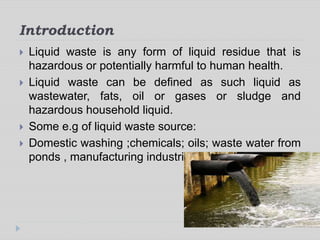Unknown Facts About Reclaim Waste
Unknown Facts About Reclaim Waste
Blog Article
What Does Reclaim Waste Do?
Table of ContentsIndicators on Reclaim Waste You Should KnowAll about Reclaim WasteExcitement About Reclaim WasteSome Known Factual Statements About Reclaim Waste All about Reclaim Waste
Explore the types, occurrences, and types of liquid waste. Domestic sewage waste describes the waste and items from a household sewage-disposal tank. This kind of waste is created by people in houses, colleges, and other buildings. This only consists of septic storage tanks that have a drainpipe field. The appropriate monitoring and disposal of domestic sewer waste call for liquid waste to be moved to a sewage therapy plant where the proper techniques and equipment are put on purify and get rid of waste.
Commercial waste commonly consists of prospective threats, such as flammable materials or a mixture of liquid and solid waste products, and needs an advanced and detailed disposal process. The disposal of industrial waste normally entails the filtering of waste prior to transportation to make certain secure and proper disposal. Industrial waste is developed from byproducts and runoff of industrial processes and manufacturing.
This type of waste can not use the same sewage management transportation or processes as septic or business fluids. The hazardous waste monitoring process calls for the examination and testing of fluid waste before it undertakes the disposal procedure (liquid waste disposal). Runoff waste is the fluid waste that originates from overflow and excess stormwater in highly booming locations or cities
Runoff waste can trigger contamination and flooding if not dealt with appropriately. Making certain correct waste administration can prevent disasters and minimize ecological harm.
The Only Guide to Reclaim Waste
Call PROS Services today to discover our waste monitoring and disposal solutions and the proper methods to take care of the liquid waste you produce.
(https://www.mixcloud.com/reclaimwaste1/)Do you understand what happens to your water when you end, purge the commode or drain pipes the washing maker? No? Well, it's worth understanding. This so-called 'wastewater' is not just an important source but, after treatment, will certainly be released to our land, rivers or the ocean. Utilized water from bathrooms, showers, baths, kitchen area sinks, laundries and industrial processes is understood as wastewater.

water made use of to cool equipment or tidy plant and equipment). Stormwater, a form of wastewater, is runoff that flows from farming and metropolitan areas such as roofings, parks, gardens, roadways, courses and seamless gutters right into stormwater drains, after rain. Stormwater moves neglected directly to regional creeks or rivers, ultimately reaching the sea.
The Basic Principles Of Reclaim Waste
In Queensland, a lot of wastewater is treated at sewer therapy plants. Wastewater is delivered from domestic or commercial sites with a system of sewers and pump stations, understood as sewerage reticulation, to a sewer therapy plant. City governments construct, keep and run most sewage treatment plants. Operators are certified under the Environmental Management Act 1994 to discharge cured wastewater at an acceptable environmental standard right into waterways.
The Department of Natural Resources encourages city governments regarding managing, operating and maintaining sewage systems and treatment plants. In unsewered areas, regional governments might require owners to set up specific or house sewage therapy systems to treat residential wastewater from bathrooms, kitchen areas, restrooms and laundries. The Department of Natural Resources authorises using household systems when they are verified to be efficient.
A lot of stormwater gets no treatment. In some brand-new class, treatment of some stormwater to remove trash, sand and crushed rock has begun using gross contaminant catches. Wastewater treatment occurs in four stages: Eliminates strong issue. Bigger solids, such as plastics and various other objects mistakenly discharged to drains, are removed when wastewater is gone through screens.
Wastewater then streams into huge containers where solids settle and are gotten rid of as sludge. Oil and residue are skimmed from the surface area. Makes use of little living organisms knows as micro-organisms to damage down and get rid of continuing to be dissolved wastes and great bits. Micro-organisms and wastes are included in the sludge. Gets rid of nitrogen and phosphorus nutrients that could cause algal blossoms in our waterways and intimidate water life.
The 20-Second Trick For Reclaim Waste
Nutrient elimination is not offered at all sewage therapy plants since it requires pricey specialised devices. Clear liquid effluent generated after therapy might still include disease-causing micro-organisms - liquid waste removal melbourne.

Most wastewater moves into the sewage system. Under the Act, regional governments carry out authorizations and permits for environmentally appropriate activities (Ages) involving wastewater releases that may have a regional Homepage impact.
How Reclaim Waste can Save You Time, Stress, and Money.
Otherwise, examples are taken for lab evaluation. Often lots of examinations are required to establish the levels of each of the various pollutants such as oils, heavy steels and chemicals in water. Monitoring gives accurate info about water top quality and can verify that licence problems are being fulfilled. The information acquired through surveillance provides the basis for making water high quality decisions.
Report this page